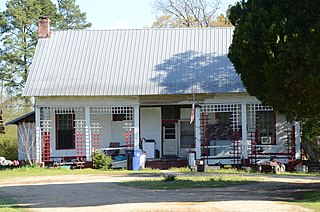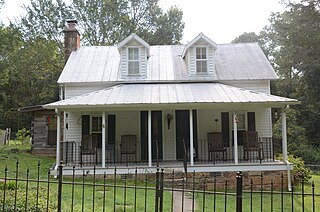Watson House may refer to:

The Homestead Farm at Oak Ridge is a historic house and grounds located in Oak Ridge Park in the township of Clark in Union County, New Jersey and extending into the township of Edison in Middlesex County. It was listed on the National Register of Historic Places on October 25, 1995, for its significance in architecture, exploration/settlement, law, military history, and politics/government. In addition to the building, the listing includes three contributing sites and one contributing object.

The Smith-McCurry House is a historic house on Arkansas Highway 15, 3.5 miles (5.6 km) east of El Dorado, Arkansas. The oldest portion of the house is a single-story dog trot house that was built in 1867 by Lawson Smith for his son David Carroll Smith. The house was inherited in 1919 by Mamie Smith McCurry, notable as a prominent investor in early oil exploration in Union County. The third well in the county, a successful gusher, was drilled on her land. She the invested further in oil exploration, forming a partnership with Bruce Hunt, a geologist, and the drillers Hensy and Zoda, and eventually participating in exploratory drilling operations in seven states. She used proceeds from her oil successes to expand the homestead and add then-popular Craftsman details to it.

The Butler-Matthews Homestead is a historic farm complex near the hamlet of Tulip in rural Dallas County, Arkansas. The property is historically significant for two reasons: the first is that it includes a collection of 15 farm-related buildings built between the 1850s and the 1920s, and it is the location of one of Dallas County's two surviving I-houses.

The Blytheville Greyhound Bus Station is located at 109 North 5th Street in Blytheville, Arkansas. It is a single-story island-type station in the Streamline Moderne architectural style, with rounded corners, and projecting canopies on either side. The main entrance also has a rounded canopy over it, and a vertical sign rising above, advertising the Greyhound Bus Lines. This station was built by the company in around 1937, when it was undergoing a major expansion campaign. The building is one of the finest examples of Art Moderne styling in the state. The station was designed by architects William Nowland Van Powell and Ben Watson White.

The Beasley Homestead is a historic house and farmstead on US Highway 71 Business (US 71B) in Bethel Heights, Arkansas. The main house, a Bungalow-style single-story structure built in 1927, is of a type common to Benton County in the 1920s. The outbuildings of the farmstead, including a barn, machine shed, and chicken house, were built at the same time and with similar detailing. The complex makes a rare complete and well-preserved farmstead from the period.

The William Dillard Homestead is a historic homestead property in rural northeastern Stone County, Arkansas. It is located on the Round Bottom area northeast of Mountain View, on a plateau above the river's flood plain. It consists of two log structures, both now used as barns, that were built c. 1837, and are the oldest standing structures in the county. A single-pen log cabin stands on rough stone piers, and is covered by a gable roof. The walls are rough-hewn logs, joined by V notches. A shed-roof ell extends on the southern side of the structure, and more modern box-constructed sheds are attached to the north and east sides. A double crib barn stands across the road from the cabin.

The Gates-Helm Farm is a historic early homestead property in rural Searcy County, Arkansas. It is located on both sides of County Road 13, north of Snowball. The property includes a single-pen log house, and a single-pen log barn, both built c. 1870, and a wood frame double-pen house built around 1900. The log structures, located down a lane on the west side of the road, were built by Peter Gates not long after purchasing the land. The house, on the east side of the road, was built by William Helm, who had married one of Gates' daughters. The property exemplifies the evolution of vernacular architecture of the period.
The Leonard Gordon Homestead, Hexagonal Grain Crib is a historic farm outbuilding in rural White County, Arkansas. It is located off County Road 69, north of Bald Knob. It is a single-story wood-frame structure, finished in board and batten siding and topped by a hexagonal hip roof. It exhibits a high quality of craftsmanship in the mitering of its structural members, suggesting it was intended to be a visually striking structure. Built about 1920, it is the only hexagonal structure identified in an architectural survey of the county.

The Louis Gray Homestead, Barn is a historic barn in rural White County, Arkansas. It is located off Arkansas Highway 157 east of Plainview. It is a two-story frame structure, with a gambrel roof and side shed, and is finished with board-and-batten siding. It is built in a transverse crib plan, with five bays on the left and six on the right, with a hay loft above. It has a hay hood. Built about 1932, it is a well-preserved and little-altered example of this form within the county.
The Brady Hays Homestead was a historic farmstead in rural northern White County, Arkansas. The property included a house and barn built about 1885 by Brady Hays. The house was a double pen frame house of vernacular style, and the barn was a notably large two story transverse crib design, incorporating an older barn into its structure.

The Marshall Hickmon Homestead is a historic house on Arkansas Highway 87 in Bradford, Arkansas. It is a 1+1⁄2-story wood-frame structure, clad in stucco, with a jerkin-headed side-gable roof and a concrete foundation. Most of its front facade is sheltered by a gabled porch, supported by sloping square columns finished in shingles and set on concrete piers. The house was built in 1933, and is a high quality local example of Craftsman architecture.

The Louis N. Hilger Homestead/Livestock Barn is a historic barn in rural northern White County, Arkansas. It is located on the south side of County Road 374, west of Providence. It is a two-story wood-frame structure, with a gambrel roof, hay hood, board-and-batten siding, and a concrete foundation. It has a transverse crib layout, with a livestock shed extending along one side. It has two shed-roof dormers on the east side, providing light to the interior. It was built in 1939 to house mules used as draught animals for the Hilger dairy operation, and is distinctive within the county for its use of dormers and its extraordinary height, made possible by its braced-frame construction.

The Samuel D. Byrd Sr. Homestead is a historic farmstead at 15966 United States Route 270, near Poyen, Arkansas. The main house of the farmstead is a single story dogtrot structure, with one log pen built in 1848, and a second pen built out of pine planking in 1850, with a gabled roof covering both pens and the breezeway between. The building has been added to several times, and some of its porches enclosed, to accommodate large families. It was occupied by members of the Byrd family until 2000, and is one of the county's oldest surviving structures.

The Henry Klotz Sr. House is a historic house of Henry W. Klotz Sr. on First Street in Russell, Arkansas. It is a single story wood-frame structure with a broad gabled roof and recessed porch. It was built in 1921 from prefabricated parts ordered by Henry Klotz from Sears, Roebuck. It is one of White County's few examples of a catalog mail-order house. The house does not match any known catalog entry by the company, suggesting that either Klotz or the builder made alterations on site.
The Lightle House is a historic house on County Road 76 in White County, Arkansas, just north of the Searcy city limits. It is a single story wood-frame structure, with a side gable roof, a shed-roof porch across the front, and a central chimney. An addition extends to the rear, giving it a T shape, with a second chimney projecting from that section. Built about 1920, it is the county's only known surviving example of a "saddlebag" house.
The John Thrasher Homestead was a historic homestead in rural White County, Arkansas. It was located north of Bald Knob and southwest of the crossroads hamlet of Midway, down a lane west of United States Route 167. It was a 1+1⁄2-story saddlebag frame house, originally built as a single-pen structure with exterior chimney c. 1885. This was later enlarged by enclosing the chimney and adding a second pen on its other side. It was, despite deteriorating condition when surveyed in 1992, one of the finest examples of this type of design in the county.

The Walker Homestead Historic District encompasses a collection of related agricultural and homesteading properties in rural White County, Arkansas. Located on Gum Spring Road about 1 mile (1.6 km) east of Arkansas Highway 267 southwest of Searcy, the district includes two farmstead houses, a barn, tenant housing, cotton gin, and other features. The oldest portion of the oldest house is a single pen log structure built about 1850 by William Walker, one of the area's early settlers, while the other house is a c. 1900 vernacular Greek Revival structure built by Billy Walker, Sr. The district encapsulates a typical evolutionary history of rural properties in the region, and was listed on the National Register of Historic Places in 1992.

The Otha Walker Homestead is a historic house on the south side of Arkansas Highway 36, east of the small town of West Point, Arkansas. It is a 1+1⁄2-story double-pile central hall plan structure, topped by a hip roof and clad in novelty siding. A porch extends across the front (north) facade and around the east side, with a shed roof that has exposed rafter ends, and is supported by wooden box columns. The house, built about 1915, is one of the few of this type built in White County between 1914 and 1939.

The Jim Wright Farmstead Historic District encompasses a well-preserved early 20th-century farmstead in rural White County, Arkansas. The property is located on the south side of Arkansas Highway 258, east of its junction with Arkansas Highway 323, northwest of Bald Knob. It includes a Craftsman style single-story wood-frame farmhouse, with a wraparound porch supported by simple Doric columns, a simple wood-frame garage, and a single-story wood-frame house for tenant workers. It also includes remnants of the farmstead's first house and barn, silo, and a cattle dipping vat. This land was homesteaded in 1860 by the parents of Jim Wright, who is credited with construction of most of the farmstead's surviving features, which were built between 1924 and 1940.

















